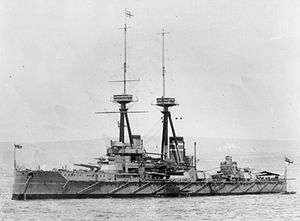
Back Линейни кораби тип „Сейнт Винсент“ Bulgarian Třída St. Vincent Czech St.-Vincent-Klasse German Clase St. Vincent Spanish St. Vincent -luokka (taistelulaiva) Finnish Classe St. Vincent French אוניות המערכה מסדרת סנט וינסנט HE Classe St. Vincent (nave da battaglia) Italian セント・ヴィンセント級戦艦 Japanese Classe St Vincent Portuguese
 St Vincent at anchor, 1909
| |
| Class overview | |
|---|---|
| Name | St Vincent class |
| Operators | |
| Preceded by | Bellerophon class |
| Succeeded by | HMS Neptune |
| Built | 1907–1910 |
| In service | 1910–1922 |
| In commission | 1910–1922 |
| Completed | 3 |
| Lost | 1 |
| Scrapped | 2 |
| General characteristics (as built) | |
| Type | Dreadnought battleship |
| Displacement | 19,700 long tons (20,000 t) (normal) |
| Length | 536 ft (163.4 m) (o/a) |
| Beam | 84 ft 2 in (25.7 m) |
| Draught | 28 ft (8.5 m) |
| Installed power |
|
| Propulsion | 4 × shafts; 2 × steam turbine sets |
| Speed | 21 knots (39 km/h; 24 mph) |
| Range | 6,900 nmi (12,800 km; 7,900 mi) at 10 knots (19 km/h; 12 mph) |
| Complement | 755–835 |
| Armament |
|
| Armour | |
The St Vincent-class battleships were a group of three dreadnought battleships built for the Royal Navy in the first decade of the 20th century. The sister ships spent their entire careers assigned to the Home and Grand Fleets. Aside from participating in the Battle of Jutland in May 1916 and the inconclusive action of 19 August several months later, their service during the First World War generally consisted of routine patrols and training in the North Sea. Vanguard was destroyed in 1917 by a magazine explosion with the near total loss of her crew. The remaining pair were obsolete by the end of the war in 1918, and spent their remaining time either in reserve or as training ships before being sold for scrap in the early 1920s.
Vanguard's wreck was extensively salvaged before it was declared a war grave. Since 2002, it has been designated as a controlled site under the Protection of Military Remains Act 1986 and diving on the wreck is generally forbidden.